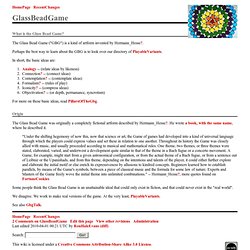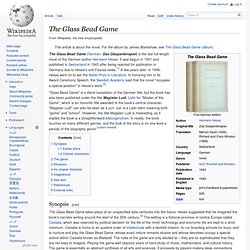

Glass Bead Game Wiki: Glass Bead Game. The Glass Bead Game ("GBG") is a kind of artform invented by Hermann_Hesse?.

Perhaps the best way to learn about the GBG is to look over our directory of PlayableVariants. In short, the basic ideas are: Analogy -- (relate ideas by likeness) Connection? -- (connect ideas) Contemplation? -- (contemplate ideas) Formalism? For more on these basic ideas, read PillarsOfTheGbg. The Glass Bead Game was originally a completely fictional artform described by Hermann_Hesse?. "Under the shifting hegemony of now this, now that science or art, the Game of games had developed into a kind of universal language through which the players could express values and set these in relation to one another. Some people think the Glass Bead Game is an unattainable ideal that could only exist in fiction, and that could never exist in the "real world". We disagree.
See also GbgTalk. Cosmic Play In a Symbolic Universe. Hermann Hesse. Biography[edit] Family background[edit] Hermann Hesse was born on 2 July 1877 in the Black Forest town of Calw in Württemberg, German Empire.

His parents served in India at a mission under the auspices of the Basel Mission, a Protestant Christian missionary society. Hesse's mother, Marie Gundert, was born at such a mission in India in 1842. In describing her own childhood, she said, "A happy child I was not... " Hesse's birthplace, 2007 Hesse's father, Johannes Hesse, the son of a doctor, was born in 1847 in the Estonian town of Paide (Weissenstein). Hesse grew up in a Swabian Pietist household, with the Pietist tendency to insulate believers into small, deeply thoughtful groups. Childhood[edit] From childhood, Hesse appeared headstrong and hard for his family to handle. St. Young Hesse shared a love of music with his mother. Education[edit] After this, Hesse began a bookshop apprenticeship in Esslingen am Neckar, but quit after three days. Becoming a writer[edit] Casa Camuzzi[edit]
The Glass Bead Game. The Glass Bead Game (German: Das Glasperlenspiel) is the last full-length novel of the German author Hermann Hesse.

It was begun in 1931 and published in Switzerland in 1943 after being rejected for publication in Germany due to Hesse's anti-Fascist views.[1] A few years later, in 1946, Hesse went on to win the Nobel Prize in Literature. In honoring him in its Award Ceremony Speech, the Swedish Academy said that the novel "occupies a special position" in Hesse's work.[2] "Glass Bead Game" is a literal translation of the German title, but the book has also been published under the title Magister Ludi, Latin for "Master of the Game", which is an honorific title awarded to the book's central character. "Magister Ludi" can also be seen as a pun: lud- is a Latin stem meaning both "game" and "school".
However, the title Magister Ludi is misleading, as it implies the book is a straightforward bildungsroman. Synopsis[edit] Earlier plans[edit] Central characters[edit]